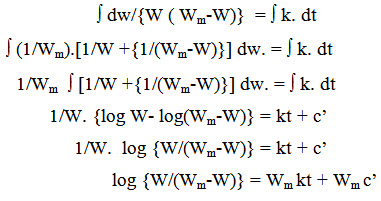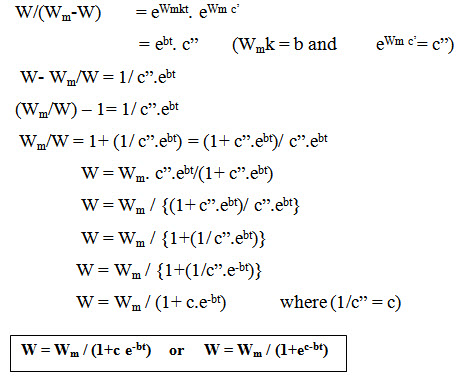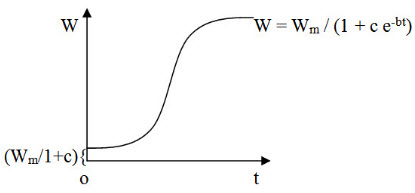Site pages
Current course
Participants
General
MODULE 1. Systems concept
MODULE 2. Requirements for linear programming prob...
MODULE 3. Mathematical formulation of Linear progr...
MODULE 5. Simplex method, degeneracy and duality i...
MODULE 6. Artificial Variable techniques- Big M Me...
MODULE 7.
MODULE 8.
MODULE 9. Cost analysis
MODULE 10. Transporatation problems
LESSON 3. Logistic Growth Model
Logistic Growth Model:
The Model:
Let W = f (t) be the growth function.
Where W = dry matter production (g plant-1)
t = time (days)
In exponential growth model we have assumed on the growth system that the changes in growth is directly proportional to
Changes in time and
Growth upto the period
If we consider the complete growth period of any species, these two assumptions will not be sufficient since these two assumptions are true only upto a particular period and there is a restriction. That is, this will be true only upto the maximum growth. If we include this assumption also i.e. the changes in growth is also directly proportional to Wm-W, where Wm is the maximum possible growth, then the resulting model is known as logistic growth model.
Assumptions of the model:
The assumptions of the logistic growth model are
-
Change in growth is proportional to change in time i.e. ΔW
 Δt.
Δt. -
Change in growth is also proportional to growth upto that stage i.e. ΔW
 W.
W. -
Also, the crop will grow upto the maximum growth only i.e. ΔW
 Wm-W.
Wm-W.
Construction of the model:
Combining the three assumptions of the model we get
∆W ![]() ∆t. W. (Wm-W)
∆t. W. (Wm-W)
∆W = k. ∆t.W.(Wm-W) where k = proportionality constant
∆W/ ∆t = k.W.( Wm-W)
Making ∆t as the smallest possible value i.e. ∆t → 0
Lt ∆t → 0 ∆W/ ∆t = k.W.( Wm-W)
i.e. dW/dt = k.W.( Wm-W)
dw/(W ( Wm-W)) = k. dt
Integrating both sides,

Raising both sides to the power of e

The Curve:
The curve will be of sigmoidal shape.

Meaning of the parameters:
1. When t = 0, W = W0 = Seed weight
e-bt = e0 = 1
W0 = Wm / (1+c)
1+c = Wm / W0
c= (Wm / W0) – 1
c is the ratio of maximum possible growth to the initial seed weight minus 1.
2. When there is no restriction i.e. t = µ
e-bt = eµ = 0
W = Wm / 1+0 = Wm
i.e. when there is no restriction, W= Wm
Application of the model:
Logistic growth model is used when the complete growth period is considered.
Estimation of Growth Rate:
W = Wm / (1+ c.e-bt)
dW/dt = {(1+ c.e-bt) . 0 - Wm (c.e-bt) (-b)}/ {1+ c .e-bt}2
= {Wm c.b.e-bt}/ {1+ c .e-bt}2
Estimation of the model:
W = Wm / (1+ c.e-bt)
W / Wm = 1+ c.e-bt
(W/Wm)-1 = c.e-bt
Taking log on both sides,
log {(W/ Wm)-1} = log c + log e-bt
= log c – bt
This is of the form
Y = A+ Bx
Where Y = log {(W/ Wm)-1} x = t
A = log c or c = eA
B = -b or b = -B
Ex.3. Estimate logistic growth model and obtain its growth rate on 50th day for the following observation in TMV 7 groundnut.
|
Time (days) |
15 |
25 |
45 |
60 |
80 |
95 |
105 |
110 |
DMP (g pl-1) |
3.25 |
5.30 |
13.50 |
25.32 |
36.96 |
42.44 |
45.70 |
47.45 |
It is observed that the maximum growth in the replicated plot is 48.5 g pl-1.
Solution:
The linear regression between log {(W/ Wm)-1} and t is estimated. The estimated co-efficients are
A = 3.7200 B = - 0.0633 (r = -0.993)
The estimated model parameters are
c = eA = e3.7200 = 41.2631
b = -B = 0.0633
The estimated logistic growth model is
Ŵ= 48.5 / {1 + 41.2631 e-0.0633t}